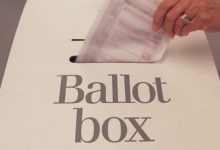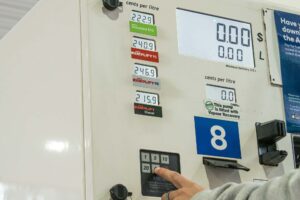As New South Wales prepares to vote in what promises to be a state election on Saturday that is too close to call, voters could be excused for wondering exactly what the major parties stand for the issues that they appear to care most about – climate and energy.
In the week after thousands of students around the state took leave from their lessons to rally for 100 per cent renewables by 2030, and for stronger action on climate change, both parties have been bafflingly quiet on either topic.
Even more surprising – as RenewEconomy contributor David Leitch notes here – is that they do actually have policies to talk about; well in energy, at least. It’s almost as if they’re avoiding the issue.
Indeed, the climate strike was all that rated a mention in the final leader’s debate hosted by Sky News and the Daily Telegraph, with Labor leader Michael Daley repeating his endorsement of action, but not seeing the opportunity to promote his policy.
Berejiklian simply confirmed she still opposed the student strikes. The only time climate entered the election window was news that treasurer Dominic Perrotet had been caught complaining about climate policies, and justifying his questioning of the science.
Why would the major parties downplay an issue that, according to a recent Fairfax Media poll, 57.5 per cent of NSW voters said they would be swayed by these policies when deciding who to vote for?
So what are the major parties’ policies on climate and energy? Let’s recap.
Starting with the current Coalition government, the party has no actual targets for renewables or emissions reduction, but has argued strongly for its federal counterpart to restore an emissions obligation into national energy policy.
In an op-ed in the Australian Financial Review in December, NSW energy minister Don Harwin called the Morrison government “out of touch on energy and climate policy,” and said this was preventing new investment and the reduction of electricity prices.
“We need to end the ‘climate wars’ and put science, economics and engineering ahead of ideology,” Harwin wrote.
“That’s why NSW wants a sensible emissions policy to be embedded in the National Electricity Law, outside the high drama of the ‘Canberra bubble’.”
What the party does offer is the promise of no interest loans for solar and battery storage for 300,000 homes, and measures to make it easier for apartment owners to approve and install solar panels and batteries.
It is also proposing $20 million to the Emerging Energy Program, encouraging private-sector investment in large-scale electricity and storage projects; and $10 million for a new recycling fund for solar panels and battery systems.
NSW Labor, meanwhile, has proposed a target for at least 50 per cent renewables by 2030, and 100 per cent for all state government agencies by 2025. It has also proposed to drive the roll-out of 7GW of large-scale renewables by 2030 – 6GW by reverse auction, and 1GW through a new state-owned corporation – and 4GW in first four-year term of government.
At the distributed renewables level, it has pledged to deliver 500,000 new solar homes by 2030, via a $2,200 subsidy along the lines of the Victorian government’s Solar Homes scheme, plus $11 million to train electricians to install home battery storage.
And most recently, NSW Labor announced $100 million to install solar PV on more than 350 schools around the state. Rumours had it that the party was also set to unveil a last-minute battery storage plan, but that policy failed to appear.
Mainstream media has gone quiet on these supposed hot button issues, too, unless you count the AFR editorial claim that state governments are creating “anarchy” in the national power grid through extreme renewables targets, or The Australian’s scare campaign against the Greens.
The Murdoch broadsheet reported on Friday that the NSW Greens would demand billions of dollars of taxpayer money be spent on renewable energy projects in regional areas as part of their price for Labor taking power in NSW through a minority government.
“We would want one gigawatt of new renewables every year for a decade,” it quotes Greens NSW leader David Shoebridge as demanding.
Never mind that Labor is already planning to do just that.
Here’s some of what’s being said on social media…
At the start of the NSW election campaign we released our clean energy policy asks. The Liberal party committed to some of the policies, while the Labor party made big strides. Thanks @michaeldalymp pic.twitter.com/W3E9JybBBi
— Kane Thornton (@kanethornton) March 20, 2019
Let’s be clear. @GladysB has no legislated target nor any proposed. The big whale. @michaeldaleyMP will “at least” a 50% target by 2030. Legislated.
As this is a #ClimateElection – we have to give the policy win to Labor (in this area). https://t.co/23onmPaaMb
Analysis of the NSW election on #insiders totally missed that Gladys and her government has zero #climate policy. #auspol
— Nicky Ison (@nickymison) March 16, 2019
— Mike Cannon-Brookes ???????????????? (@mcannonbrookes) March 20, 2019
The question is will the Australian people buy the Coalition’s line and be played for a fool a 2nd time?
The polling, the size of the school #climatestrikes and the on the ground experience of campaigners suggests not. #climateelection #auspol
— Nicky Ison (@nickymison) March 19, 2019
And finally, below is the energy and climate policy scorecard Greenpeace Australia Pacific and Nature Conservation Council of NSW will be handing out at polling stations tomorrow, over which the Coalition is threatening to take electoral commission if they lose in key marginal seats.
BREAKING: the NSW Liberal Party is threatening to take us to court for calling out their poor environment policies in our independent election scorecard! If they don’t like the result, they need to change their policies. Share the scorecard! #NSWVotes #nswpol #saveourkoalas pic.twitter.com/oTI7CYAQux
— Nature NSW (@naturensw) March 21, 2019








